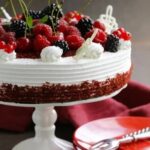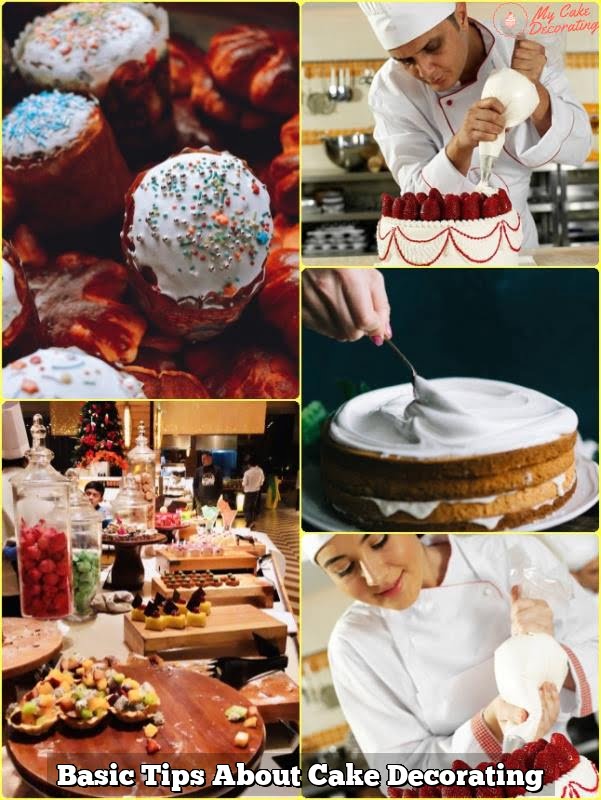Cake decoration is an essential part of baking that can truly transform a simple cake into a stunning masterpiece. In this article, we will discuss how to do a basic trim decoration on a cake, focusing on techniques that anyone can easily master.
Adding a trim to your cake can elevate its overall look and make it more visually appealing, whether you are baking for a special occasion or simply want to impress your friends and family with your baking skills.
To achieve a beautiful trim decoration on your cake, you’ll need the right tools and materials. From piping bags and tips to fondant cutters and spatulas, having the necessary equipment is crucial for creating intricate designs.
Choosing the right cake base is also important when it comes to decorating, as certain types of cakes work better with different trim techniques. Whether you’re working with a classic sponge cake or a rich chocolate ganache, selecting the perfect cake can make all the difference in achieving a flawless finish.
In the following sections, we will delve into preparing the cake for decoration, exploring various basic trim techniques such as piping, icing, and fondant application. Our step-by-step tutorial will guide you through the process of creating a basic trim decoration on your cake, complete with clear instructions and helpful images to ensure success. So grab your tools and get ready to unleash your creativity as we explore the art of basic trim decoration on cakes.
Tools Needed
Piping Bags and Tips
One of the essential tools needed for basic trim decoration on a cake is a piping bag and tips. Piping bags allow you to pipe different designs, borders, and patterns onto your cake using icing or frosting. Make sure to have a variety of piping tips such as round tips for lines and dots, star tips for borders and rosettes, and leaf tips for foliage designs.
Offset Spatula
An offset spatula is another crucial tool for creating a smooth finish on your cake before applying the trim decoration. This tool helps in spreading icing or frosting evenly on the cake surface and edges, ensuring a clean canvas for your decorations. It also helps in achieving sharp edges and corners on the cake.
Fondant Smoother
If you plan on using fondant for your basic trim decoration, a fondant smoother is a must-have tool. This tool helps in smoothing out any wrinkles or air bubbles in the fondant, giving your cake a professional look. It also helps in shaping the fondant around the cake seamlessly, making it easier to create intricate trim designs.
Having these essential tools in your cake decorating toolkit will make the process of doing a basic trim decoration on a cake much more seamless and enjoyable. Experiment with different techniques and designs to find what works best for you and have fun transforming simple cakes into works of art with beautiful trim decorations.
Choosing the Right Cake
Flavor and Texture
The first thing to consider when choosing a cake for decoration is the flavor and texture. Make sure to select a flavor that complements the trim you plan on adding.
For example, if you’re going for a classic look with a white buttercream trim, a simple vanilla or chocolate sponge cake would work well. On the other hand, if you’re planning on using fondant trim with intricate decorations, a firmer cake like a carrot or red velvet might be more suitable.
Stability
Another important factor to consider is the stability of the cake. A sturdy and dense cake will hold up better under the weight of decorations compared to a light and fluffy one. Opt for cakes that are moist but still have enough structure to support any added trim or embellishments. This will ensure that your decoration stays in place and looks flawless throughout your event.
When selecting the perfect cake for decorating with a basic trim, keep in mind these tips on flavor, texture, and stability. By choosing the right base for your decoration, you’ll set yourself up for success in creating a stunning and delicious creation that will impress your guests. Now let’s move on to preparing the chosen cake for decoration in our next section.
Preparing the Cake
After leveling your cake layers, it’s essential to apply a crumb coat before adding any decorations. A crumb coat is a thin layer of frosting that seals in the crumbs on the surface of the cake, providing a smooth foundation for the final decoration. To apply a crumb coat, simply spread a thin layer of frosting over the entire cake, making sure to cover any exposed cake crumbs.
Once you’ve leveled your cake layers and applied a crumb coat, you’re ready to start decorating with a basic trim. Whether you choose to use piping, icing, or fondant for your trim decoration, having a well-prepared cake will make the process much smoother and more enjoyable. With these steps completed, you can move on to the next stage of creating a beautifully decorated cake that will impress your family and friends.
| Step | Description |
|---|---|
| 1 | Level your cake layers using a serrated knife or cake leveler. |
| 2 | Apply a crumb coat by spreading a thin layer of frosting over the entire cake. |
| 3 | Having prepared your cake layers, proceed with your chosen basic trim decoration technique. |
Basic Trim Techniques
When it comes to decorating a cake with a basic trim, there are several techniques that you can use to achieve a beautiful and professional-looking finish. Piping is one of the most common techniques used for basic trim decoration on cakes.
This involves using a piping bag to create intricate designs or borders on the surface of the cake using buttercream frosting or royal icing. Piping allows for precision and control, making it ideal for creating delicate details or writing messages on the cake.
Another popular technique for basic trim decoration is using icing. Icing can be spread over the entire surface of the cake to create a smooth finish, or it can be used to create textured designs and patterns. Icing can be colored and flavored according to your preference, allowing for endless possibilities when it comes to decorating your cake. With the right tools and a bit of practice, you can create stunning designs using icing as a basic trim decoration technique.
Lastly, fondant is another versatile option for basic trim decoration on cakes. Fondant is a pliable sugar paste that can be rolled out and draped over the cake to create a smooth and flawless finish. Fondant can also be molded into various shapes and decorations before being placed on the cake’s surface.
This technique is great for achieving clean lines and sharp edges in your basic trim decoration. Experimenting with different colors and textures of fondant can result in unique and visually appealing designs on your cake.
Incorporating these basic trim decoration techniques such as piping, icing, and fondant into your cake decorating repertoire can take your creations to the next level. By mastering these techniques and experimenting with different designs and patterns, you can elevate the look of any cake with a simple but effective trim decoration. With practice and patience, you’ll soon discover how rewarding it is to add personalized touches to your cakes through these creative methods.
Step-by-Step Tutorial
Decorating a cake with a basic trim can add that extra touch of elegance and charm to your baked creation. Whether you are a beginner or an experienced baker, mastering the art of basic trim decoration can take your cake presentation to the next level. In this tutorial, we will guide you through the step-by-step process of adding a simple yet beautiful trim to your cake.
To begin with, let’s gather the necessary tools and materials for this project:
- Offset spatula
- Piping bags
- Piping tips (such as round tips for piping borders)
- Buttercream or royal icing
- Fondant (optional)
- Cake turntable
- Cake smoother
Now that you have all your tools ready, it’s time to choose the right cake for decorating. A smooth and even surface is ideal for applying a basic trim decoration. You can either bake a fresh cake or use a pre-made one from the store. Make sure the cake is cooled completely before starting the decoration process.
Once you have selected your cake, it’s crucial to prepare it properly before adding any decorations. This involves leveling the top of the cake to create an even surface and then applying a crumb coat to seal in any loose crumbs. The crumb coat also acts as a base for the final decorations, ensuring a clean and professional finish.
With these steps completed, you are now ready to move on to the actual basic trim decoration techniques. Using your piping bag filled with buttercream or royal icing, practice creating different borders and designs on your cake. If you prefer working with fondant, roll it out into thin strips and use them as decorative trims on your cake.
By following these guidelines and experimenting with different basic trim techniques, you’ll soon be able to confidently decorate cakes with beautiful embellishments. Let your creativity flow and enjoy the process of enhancing your cakes with stylish trim decorations.
Troubleshooting
When it comes to decorating cakes with a basic trim, there may be some common issues that can arise during the process. It’s important to be prepared for these challenges and know how to troubleshoot them effectively. Here are some of the common issues you may encounter while decorating a cake with a basic trim, along with tips on how to fix them:
1. Crumbs in the frosting: One common issue that many bakers face when decorating a cake is getting crumbs in the frosting. This can make the final result look messy and unprofessional. To avoid this, make sure to crumb coat your cake before adding the final layer of frosting. A crumb coat is a thin layer of frosting that seals in any crumbs and provides a smooth base for your final decorations.
2. Uneven or lumpy icing: If you find that your icing is coming out uneven or lumpy when decorating your cake, it may be due to the consistency of the icing.
To fix this issue, try adjusting the consistency of your icing by adding more powdered sugar if it’s too thin or a little bit of milk if it’s too thick. You can also use an offset spatula to smooth out any uneven areas on the cake.
3. Piping mistakes: When piping decorations onto a cake, it’s easy to make mistakes such as uneven lines or blobs of icing in unwanted places. To fix piping mistakes, you can gently scrape off any excess icing with a toothpick or small spatula. You can also cover up minor mistakes by adding extra decorations such as edible flowers or sprinkles.
By being aware of these common issues and knowing how to fix them, you’ll be better equipped to tackle any challenges that may come up while decorating your cake with a basic trim decoration technique. With practice and patience, you’ll soon master the art of creating beautifully decorated cakes that are sure to impress your friends and family.
Inspiration and Ideas
When it comes to cake decorating, the possibilities are truly endless. A basic trim decoration on a cake can add that extra flair and elevate the overall look of your creation. Whether you are a beginner or an experienced baker, incorporating creative ideas into your basic trim decorations can make your cakes stand out and impress your guests. In this section, we will explore various inspiration and ideas for different types of basic trim decorations on cakes.
One fun and simple way to add a unique touch to your cake is by using fresh flowers as part of the trim decoration. Edible flowers like pansies, violets, or roses can be strategically placed around the edges of the cake to create a beautiful and natural look.
Make sure to wash and dry the flowers thoroughly before adding them to the cake to ensure they are safe for consumption. This elegant touch will not only enhance the aesthetic appeal of your cake but also provide a delightful floral fragrance.
For those looking for a more whimsical approach, consider using colorful sprinkles or edible glitter as part of your basic trim decoration. Sprinkles can be used in various ways – sprinkled over the top of the cake in a uniform pattern or arranged along the edges for a more playful look.
Similarly, edible glitter can add a touch of magic and sparkle to your cake, making it perfect for special occasions like birthdays or celebrations. Just remember that less is often more when it comes to using glitter, so use it sparingly for an eye-catching effect.
Another trendy idea for basic trim decoration is incorporating geometric shapes into your design. Use fondant cutters or stencils to create shapes like triangles, squares, or diamonds from colored fondant or icing. Arrange these geometric shapes around the base of the cake or create a geometric pattern on top for a modern and stylish appearance. This contemporary approach to basic trim decoration will surely make your cake visually striking and Instagram-worthy.
| Ideas | Description |
|---|---|
| Fresh Flowers | Use edible flowers like pansies or roses around the edges for an elegant touch |
| Sprinkles and Glitter | Add colorful sprinkles or edible glitter sparingly for a whimsical effect |
| Geometric Shapes | Create modern patterns with geometric shapes made from colored fondant or icing |
Conclusion
Cake decoration is an essential aspect of baking that adds flair and personality to any dessert. A simple trim can transform a plain cake into a stunning masterpiece, showcasing your creativity and attention to detail. By following the step-by-step instructions and tips provided in this article on how to do a basic trim decoration on a cake, even beginners can achieve professional-looking results.
In order to successfully decorate a cake with a basic trim, it is crucial to have the right tools and materials at hand. From piping bags to fondant tools, each item plays a vital role in creating intricate designs and patterns on your cake. Additionally, selecting the perfect cake base and properly preparing it for decoration are key steps in ensuring a smooth decorating process.
For those looking to enhance their baking skills and impress friends and family with beautifully decorated cakes, learning how to do a basic trim decoration is a great starting point. The techniques outlined in this article, such as piping, icing, and fondant work, offer endless possibilities for creativity.
Don’t be afraid to experiment with different styles and designs – the more you practice, the better you will become at achieving flawless decorations on your cakes. So go ahead, roll up your sleeves, grab your tools, and start decorating.

Welcome to my blog about home and family. This blog is a place where I will share my thoughts, ideas, and experiences related to these important topics. I am a stay-at-home mom with two young children. I hope you enjoy reading it! and may find some helpful tips and ideas that will make your home and family life even better!





